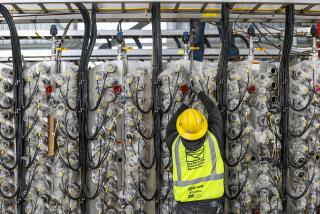Deal reached on Owens Lake dust battle
- Share via
LONE PINE, CALIF. — In an effort to end decades of bitter conflict, Los Angeles water officials on Wednesday announced a proposed agreement to expand its dust control effort on dry Owens Lake at a cost of $105 million.
The project, already dogged by huge cost overruns, would construct dust control berms on an additional 12.7 square miles of lake bed by 2010, giving the project an overall price tag of about $520 million.
The agreement was a source of elation for the environmental community because of the dust problem that has plagued the Owens Valley for decades.
“It’s extremely important because it’s a commitment by the city to fix a massive regional health problem,” said Mike Prather, a longtime Owens Valley environmental activist. “They are complicit in [the problem] and they have made a conscious decision to do what is necessary to fix it. They should be commended for that.”
The announcement is only the latest chapter in a dispute between the city and rural Owens Valley residents who have had to suffer through epochal dust storms here since Los Angeles began diverting water from the valley in 1913, drying up the lake and turning much of the region into a desert.
In the past, the Los Angeles Department of Water and Power has used flooding, plants and gravel to tamp down the dust.
Under the proposed process, called “moat and row,” airborne dust particles would be captured in a specially configured ridged landscape. It has not been tried at the lake before, though it has elsewhere, and a test project will precede full implementation.
The original estimate for reducing dust in a 30-square-mile area of the Owens Valley was $120 million.
The negotiated settlement calls for the DWP and the local Great Basin Air Pollution Control District to work cooperatively to bring Owens Lake into compliance with the federal Clean Air Act’s standard for fine dust particles at one of the most significant sources of air pollution in the Southwestern U.S.
The DWP also will dismiss its lawsuit against the air district. The pact could signal a retreat by the DWP from its long history of delays in correcting environmental damage in the valley.
DWP officials said Los Angeles will see significant savings because the agreement will avoid further costly litigation against the Great Basin district.
“When this last project is done, we’ll be as close to fixing the lake as possible,” said Ted Schade, control officer for the district. “There will be no more major projects on Owens Lake.”
H. David Nahai, president of the DWP Board of Water and Power Commissioners, described the negotiations as an “intensive but amicable mediation process.”
Schade characterized the talks differently: “We battled over every single word.”
On Wednesday, an Inyo County supervisor recalled how the dust colored life in the region. “At their worst they were nasty, acrid dust storms with the ability to etch the paint off your car,” Richard Cervantes said.
Standing on a gravel berm at the edge of the dry lake that a century ago was filled with water 50 feet deep in places, he surveyed what he called “a mind-boggling, desolate landscape.”
The proposed settlement is the latest in a series of events that have pitted the DWP against Owens Valley residents, environmental groups and state officials fed up with the city agency’s failure to comply with a legal agreement to restore the once-vibrant Inyo County river.
The legal dispute underlines acrimony that has boiled in the Owens Valley since the early 1900s, when the city had agents pose as farmers and ranchers to buy land and water rights in the valley, then began building an aqueduct to slake the thirst of the growing metropolis more than 200 miles to the south.
louis.sahagun@latimes.com michael.kennedy@latimes.com Sahagun reported from Lone Pine, Kennedy from Los Angeles.
More to Read
Sign up for Essential California
The most important California stories and recommendations in your inbox every morning.
You may occasionally receive promotional content from the Los Angeles Times.














